| CONSTANCE MEYER Articles |
|
Heaven for a plucky few
For its players, the harp sets the gold standard with an ethereal 'carpet of sound.' April 22, 2007 | by Constance Meyer | The Los Angeles Times
Neill loves the harp's "plucked sound, which really does take you into a very beautiful world." Its players "sit behind the instrument getting it full-force on our
"Being in the middle of the orchestra is the best seat in the house," Dickstein says. "People should pay to be where I am." The fact is, however, that though the harp has existed all over the globe as a solo instrument, in one form or another, since ancient times, it wasn't until 1810 that a Frenchman, piano maker Sebastien Erard, invented the double-action pedal harp -- the standard 80-pound, 46- or 47-string orchestral instrument we know today. It has seven pedals, one for each note in the conventional Western scale, that tighten the strings so their pitch is sharp, flat or natural. As Neill puts it: "The left hand is bass, the right hand treble. All the chromatic capabilities are in your feet." Before Erard's invention, harps simply weren't used in orchestral writing. "Women played them in salons," says Dickstein.
As Neill sees it, "the 20th century has been our time. Stravinsky wrote a lot of very important harp parts. He didn't necessarily write well for the instrument, but they're brilliant, so all harpists try to play them the way he wanted.
" Moreover, according to Metropolitan Opera principal harpist Deborah Hoffman, "Now that the harp is so developed and there are no limitations to chromatic possibilities, composers such as Elliott Carter, John Adams, John Harbison, Philip Glass and numerous others write pieces, often very difficult, where the harp is used prominently." Hoffman recently played in the Met's premiere of Tan Dun's "The First Emperor," which, she says, "in contrast to the typical lush, rich and warm glissandi, used the instrument in a more percussive manner, creating a more aggressive, harsher, even brutal tone."Strength comes into play
Whether male or female, harpists seem to agree that strumming the instrument is the least of their worries. Pushing the right pedal at the right time is far more complex, a bit like driving with a stick shift. Says Van Voorhees: "If I'm in the key of C and the pedals are all in one spot and it modulates to the key of G, then while I'm playing I'm moving the F pedal to F sharp. That affects all the Fs on the harp. On the organ, when you move a pedal it's just for that single note." To ease the burden, Neill explains, "the strings are color-coded, because they feel the same. Cs are red, Fs black and everything in between is beige. We're looking at the harp, at the colors, at the music, at the conductor."
As a child, Hoffman studied with a Salzedo teacher in the winter and a 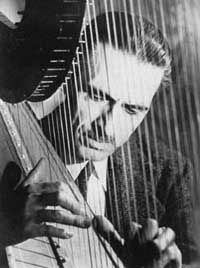 Grandjany teacher in the summer. "My elbows would be up during the
winter, down during the summer," she recalls. "Salzedo players keep their elbows up in the air to make
these big gesticulations, which they think helps to bring out the sound. It was very awkward for me and didn't feel good. I developed tendinitis from the tension of switching. When I was growing up, though, it seemed that Salzedo people occupied
the big jobs. They were really strong players who seemed to have these gigantic sounds." Still, Hoffman wound up attending the Juilliard School, where she studied the French method with the renowned Susann McDonald, a student of Renie. Grandjany teacher in the summer. "My elbows would be up during the
winter, down during the summer," she recalls. "Salzedo players keep their elbows up in the air to make
these big gesticulations, which they think helps to bring out the sound. It was very awkward for me and didn't feel good. I developed tendinitis from the tension of switching. When I was growing up, though, it seemed that Salzedo people occupied
the big jobs. They were really strong players who seemed to have these gigantic sounds." Still, Hoffman wound up attending the Juilliard School, where she studied the French method with the renowned Susann McDonald, a student of Renie.
Hoffman sees the harp in any symphony setting as "adding a certain color, a carpet of sound." In opera, she says, it's "accompaniment for the voice. Sometimes you may not know that the harp is playing, but you would certainly know it's not there if you didn't hear it." In ballet's spotlight BUT, as Allen can attest, the harp's greatest prominence is in 19th century ballet scores. One of three sisters who are accomplished harpists, Allen had just finished a stint with the San Francisco Symphony when she was approached 17 years ago about auditioning for the harp spot with ABT. She took the audition, she says, despite having had her first child just days before, "really just to get back into shape. I had two weeks to learn the repertoire," her stiffest competition turned out to be a jackhammer on the floor above "and I broke a string." Nevertheless, she got the gig -- without having a clue about the harp's workload in ballet. "Next to the solo violin, it's the most featured instrument," she says. "On average, there are 45 solos per season, within two months. While any major orchestra with a harp audition is going to have 'Nutcracker' on the list, that's about it. Unless you're in a company, you're not going to be doing the standards: 'Corsaire,' 'Bayadere,' 'Don Q,' 'Raymonda,' 'Sleeping Beauty,' 'Swan Lake.' It's pretty stressful."
For the moment, Van Voorhees has settled in L.A. to work with Neill, in association with the Young Musicians Foundation to create The Harp In Our Public Schools Project, although she eventually plans to return to the Louisiana Philharmonic. There are 38 third- and fourth-graders at Moffett Elementary School in Lennox. Some of the kids played at a Target during the holidays to thank the retailer for donating money to the school. In February, they performed for Dana Gioia, chairman of the National Endowment for the Arts, and Rep. Jane Harman (D-Venice). The students in Lennox are learning on Dusty Strings' Ravenna folk harps, which have 26 strings, not 40-odd, and cost $745 as opposed to the $50,000 that the harps audiences see on the concert stage and in orchestra pits frequently command. But Neill, who has taught at Moffett for several years, says the lustrous vision of a full-size harp remains the gold standard for her students. At the beginning of each group's first class, she tells her pupils that "they're going to get to play the gold harp at the end of the lesson. I save about 15 minutes and, with the help of the teacher, we line them up and they sit down and I show them how to play glissando. The look on their faces is priceless."
|
|
Copyright 2007 Constance Meyer. All rights reserved
|
|
|
|
|
|
|
|
|
|
|
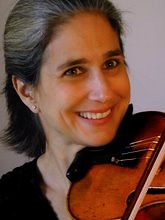
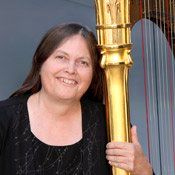 ANYONE attending a symphony concert can spot the gorgeous, gleaming harp,
even from the last row of the last balcony. Children and adults alike gasp at the size of it, at its sparkling gold crown towering above the musicians.
Lou Anne Neill, principal harpist of the Los Angeles Philharmonic for the last 24 years, remembers the first time she glimpsed a harp in the back of an orchestra.
"I couldn't see the strings from where I was sitting," she says.
"I just saw hands move through the air, and these beautiful sounds were coming out of the instrument."
ANYONE attending a symphony concert can spot the gorgeous, gleaming harp,
even from the last row of the last balcony. Children and adults alike gasp at the size of it, at its sparkling gold crown towering above the musicians.
Lou Anne Neill, principal harpist of the Los Angeles Philharmonic for the last 24 years, remembers the first time she glimpsed a harp in the back of an orchestra.
"I couldn't see the strings from where I was sitting," she says.
"I just saw hands move through the air, and these beautiful sounds were coming out of the instrument."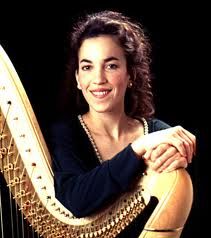 shoulder."
Marcia Dickstein, a busy L.A. freelance harpist,
also relishes "the physical sensation as the vibration goes through your body, since you wrap yourself in sound."
shoulder."
Marcia Dickstein, a busy L.A. freelance harpist,
also relishes "the physical sensation as the vibration goes through your body, since you wrap yourself in sound."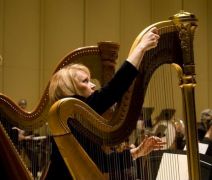 Even now, notes
Even now, notes
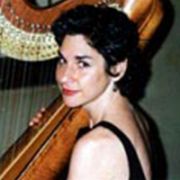
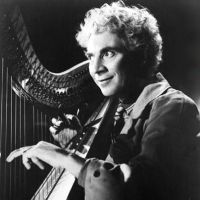 DESPITE the harp's size and heft, Dickstein
reports that "you go to a harp convention, it's 90% women." Says Van Voorhees: "We all have this image of a dainty female playing the harp, but quite honestly,
it takes a tremendous amount of upper-body strength, physical coordination and stamina, and men would have a natural advantage." In fact, it was a man,
Harpo Marx of the Marx Brothers, who was probably responsible for introducing more people to the harp than anyone else.
"When you see him play," says Hoffman, "it's absolutely magical. He goes into this world. He's not funny anymore."
DESPITE the harp's size and heft, Dickstein
reports that "you go to a harp convention, it's 90% women." Says Van Voorhees: "We all have this image of a dainty female playing the harp, but quite honestly,
it takes a tremendous amount of upper-body strength, physical coordination and stamina, and men would have a natural advantage." In fact, it was a man,
Harpo Marx of the Marx Brothers, who was probably responsible for introducing more people to the harp than anyone else.
"When you see him play," says Hoffman, "it's absolutely magical. He goes into this world. He's not funny anymore."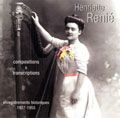 In the U.S., there are two primary schools of harp playing. One, codified by the French harpist and composer
In the U.S., there are two primary schools of harp playing. One, codified by the French harpist and composer
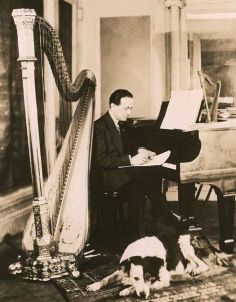 "Everything about them is different," says Dickstein, "even the way you read and mark music. For instance, you can mark pedalings within, below or above the staff -- in French, English or pedal diagrams. There's no right way.
"Everything about them is different," says Dickstein, "even the way you read and mark music. For instance, you can mark pedalings within, below or above the staff -- in French, English or pedal diagrams. There's no right way.
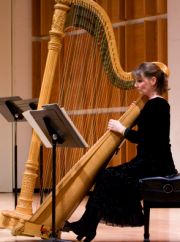 Such distinctions seem to be waning.
Such distinctions seem to be waning.
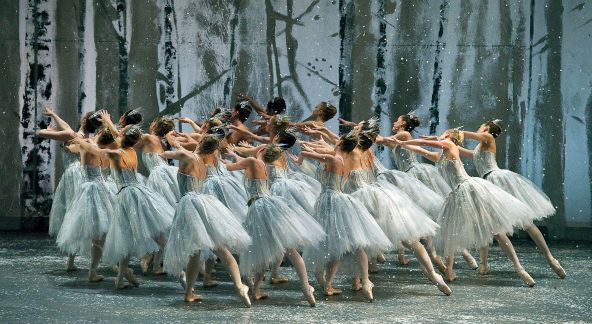 Allen remembers breaking into a sweat some years ago as she worked to replace a broken string within a nine-minute tacet, or period of silence, she had during "Swan Lake." The string needed to be stretched as much as possible so it would be
in tune for her cadenza -- what Neill refers to as "the mother of all cadenzas," which leads into the Prince's first
pas de deux with the Swan Queen. Consequently, Allen was flabbergasted at intermission when the conductor's wife said, "Barbara,
I never knew how interesting it was to watch you change a string!" Apparently "everyone in that first and second tier could see me."
Allen remembers breaking into a sweat some years ago as she worked to replace a broken string within a nine-minute tacet, or period of silence, she had during "Swan Lake." The string needed to be stretched as much as possible so it would be
in tune for her cadenza -- what Neill refers to as "the mother of all cadenzas," which leads into the Prince's first
pas de deux with the Swan Queen. Consequently, Allen was flabbergasted at intermission when the conductor's wife said, "Barbara,
I never knew how interesting it was to watch you change a string!" Apparently "everyone in that first and second tier could see me."